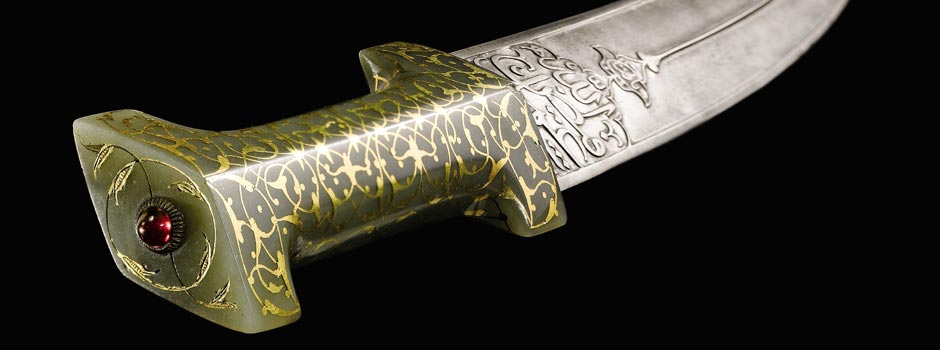
Sotheby’s Sale of ‘Arts of the Islamic World’ Featuring Rare Manuscripts and Noble Jewellery
Apr 25, 2012 Art Auction

Benedict Carter, Deputy Director and Specialist for Sotheby’s Middle East Department, said: “This sale presents an opportunity for collectors and institutions to acquire rare and exquisite Islamic works of art, many of historical significance and distinguished provenance. We are also delighted to offer 'Part Two of the highly esteemed Harvey B. Plotnick Collection', which had been assembled over the past two decades with an eye towards excellence and rarity.â€
A magnificent dagger (jambiya) with Ottoman goldinlaid jade hilt and Safavid watered-steel blade signed by Faizallah Shushtari, from Isfahan, Persia, first quarter of the 17th century, is estimated at £400,000 – 600,000. Its discovery is an exciting addition to the group of recorded works by the master craftsman Faizallah Shushtari, who was amongst the greatest steel-makers of the Safavid age. His employment by Shah Sultan Husayn suggests that this piece was most probably a royal commission, as evidenced in the superb watered steel blade and the imperial-quality Ottoman jade hilt.
Image above: A dagger (jambiya) with Ottoman goldinlaid jade hilt and Safavid watered-steel blade signed by Faizallah Shushtari, Isfahan, Persia, first quarter of the 17th century / Estimated at £400,000 – 600,000 / Courtesy of Sotheby's
A rare and important Ottoman sabre and scabbard with silver-gilt mounts set with turquoise and gold-inlaid jade panels from Turkey, first half of the 17th century, is estimated at £350,000 – 600,000. This impressive Ottoman sabre would have been made and used for ceremonial purposes or as a diplomatic gift, displaying the magnificence and wealth of the Ottoman Empire. Its appearance on the market is a once-in-a-generation opportunity to acquire a work of great rarity and museum-quality importance.
.jpg) A rare and important Ottoman sabre and scabbard with silver-gilt mounts set with turquoise and gold-inlaid jade panels from Turkey, first half of the 17th century / Estimated at £350,000 – 600,000 / Courtesy of Sotheby's
A rare and important Ottoman sabre and scabbard with silver-gilt mounts set with turquoise and gold-inlaid jade panels from Turkey, first half of the 17th century / Estimated at £350,000 – 600,000 / Courtesy of Sotheby's
An illustrated and illuminated leaf from the Shah Isma’il II Shahnameh: 'The Party After Homage Paid to Kay Khosraw by Nobles Following His Enthronment,' ascribed to the artist Burji and originating from Qazvin, Persia, circa 1577, carries an estimate of £60,000 – 80,000. This imperial manuscript epitomises the grandeur and accomplishment of the Qazvini school at its zenith and is particularly significant within the history of Persian painting. Shah Isma’il II probably commissioned this Shahnameh at the beginning of his rule in 1576, assembling an atelier of young artists in the capital city of Qazvin. The manuscript was exhibited at the Musée des Arts Décoratifs in Paris and at a later date more than half the pages were purchased by Edmond de Rothschild. Other leaves from the same manuscript are in the Collection of Prince and Princess Sadruddin Aga Khan; the Reza Abbasi Museum in Tehran; and the Art and History Collections Trust in England. The illuminated frontispiece to this manuscript, undiscovered until now, is also being offered in this sale.
An Artuqid silver-inlaid brass basin made for Sultan Qara Arslan Ibn Il Ghazi, from Mardin, Anatolia, second half of the 13th century, is estimated at £300,000 – 500,000. The rediscovery of this basin inscribed with the full title of Sultan Abi'l-Harith Qara Arslan ibn Il Ghazi, Artuqid ruler of Mardin, is one of the most important additions to the corpus of western Islamic metalwork since the end of the Second World War, and the only one of its kind still in private hands. The inscriptions have only once been published in full, and have not been seen fully in public until now, making this sultan’s 'Coronation Basin' of major significance for scholars and collectors.
.jpg) An Artuqid silver-inlaid brass basin made for Sultan Qara Arslan Ibn Il Ghazi, from Mardin, Anatolia, second half of the 13th century / Estimated at £300,000 – 500,000 / Courtesy of Sotheby's
An Artuqid silver-inlaid brass basin made for Sultan Qara Arslan Ibn Il Ghazi, from Mardin, Anatolia, second half of the 13th century / Estimated at £300,000 – 500,000 / Courtesy of Sotheby's
The sale features a rare group of 18th-19th century Moroccan gold jewellery which provides a fascinating insight into a blending of cultures at a time when collaboration between Jews and Muslims in Morocco was at its zenith. The pieces in the collection reflect the skilled work of Jewish goldsmiths, who adapted stylistic elements from a number of Berber and Arab designs. This collection belonged to the Tazi family, one of the leading families of Tangier. Many pieces were royal gifts, set with diamonds, emeralds, rubies and pearls, highly cherished for their beauty as well as symbolic value. The items are distinguished by their execution entirely in gold, unlike the more common silver jewellery of Morocco.
*Estimates to not include buyer’s premium
For more information, and to browse e-catalogue with all 290 lots, please visit SOTHEBY'S
Comments
Add a comment